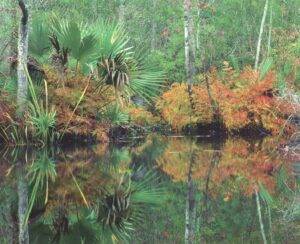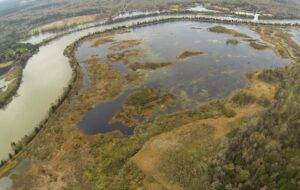Happy New Year from the South Coast office of the Coastal Conservation League! We hope you rang in 2024 with a serving of collard greens to bring you wealth, and a scoop of hoppin’ john for good luck!
Stick around to learn about our advocacy to protect historic rice fields and sensitive landscapes along the New River, from its headwaters in Hardeeville to its mouth near Palmetto Bluff.
New Year, New River Advocacy 
In December, we learned of renewed plans for over 2,600 homes on the Karrh Tract, a 2,200+ acre property recently annexed into the City of Hardeeville that is over half wetlands (1,183 acres). The wetlands form the headwaters of the New River and 275-acres were historically used for rice production.
Since the spring of 2022, the Conservation League has advocated for protection and restoration of the Karrh Tract’s extensive natural resources, including the rice fields. Rice fields provide critical habitat for waterfowl and wading birds and can help improve water quality, offsetting the impacts of rapid growth.
Bordering Beaufort and Jasper County, the 30-mile long New River is classified as Outstanding Resources Waters. However, according to the SC Watershed Atlas, its upper reaches are impaired for fecal coliform while lower reaches are impaired for turbidity. Land protection along the water’s edge can help improve the health of this embattled resource.
The “Long” Island Story, Short
Suburban sprawl near the New River headwaters stands to further impair water quality downstream at places like Long Island. Long Island is a remote hummock island within the Palmetto Bluff Planned Development where plans for 31 luxury homes were set into motion in November 2023.
The Conservation League continues to push for a permanent conservation outcome for this remote island, only accessible by a narrow causeway. Marsh hummocks contain a high diversity of habitats and plant communities, including isolated wetlands, forests, shrub thickets and grasslands. Hummocks also provide critical resting and breeding grounds for migratory birds including wood storks and painted buntings.
Marsh hummocks like Long Island are increasingly prone to tidal flooding, storm surge, and sea level rise—the wrong place for new development. In the New Year, we are committed to championing efforts to conserve the New River’s banks, from its historic rice fields near its headwaters in Hardeeville, to its island hummocks near Palmetto Bluff.
A Monumental Feat of Engineering 
In addition to many ecosystem services, rice fields tell an important, albeit tragic story that should not be ignored or taken for granted. Built on the backs of the skilled labor of enslaved persons brought from rice cultivating regions in West Africa, rice culture began in the United States in the 1670s and ended with the Civil War. Enslaved laborers perfected the science of cultivating “Carolina Gold”–a prized variety named after its color in the fields.
While the enslaved toiled in perilous and malarial conditions, their oppressors accrued extravagant wealth. Recent research reveals that slavery-driven rice culture transformed more than 95,000 hectares of wetlands in South Carolina–a truly monumental feat of engineering. According to the Carolina Gold Rice Foundation, the end of the Civil War, coupled with storm events and the mass production of other strains of rice led to the decline of Carolina Gold Rice.
Heritage Rice Makes an Epic Comeback
Did you know that Carolina Gold Rice was first reintroduced in Jasper County by Dr. Richard Schulze, an eye-doctor from Savannah? An avid waterfowler, Dr. Schulze brought back the crop from the brink of extinction in 1980’s to feed migratory ducks on his hunting property, Turnbridge.
The doctor reached out to the USDA’s Rice Research Institute in Texas, where Carolina Gold seeds were preserved in a seed bank. Agronomist Richard Bollock was able to successfully propagate the seeds and later sent 14 pounds of rice to South Carolina. The first batch yielded 64 pounds the following spring—and 10,000 pounds by 1988!
Carolina Gold’s popularity in the kitchen has also blossomed in recent years amid a growing niche market for heritage grains. Culinary experts from around the world seek out our homegrown rice for its slightly nutty flavor. Likewise, Southern Living Magazine praises the grain for its “textural, earthy mouthfeel” and its health benefits.
Continuing a Legacy in Levy
If you’re like me and you can’t get enough Hoppin’ John, check out Rollen Chalmers’ classic Lowcountry rendition of the dish made with Carolina Gold Rice and Sea Island Red Peas. Rollen Chalmers is a Hardeeville native who thanks Anson Mill’s founder Glenn Roberts and Richard Schultz, Jr. for giving him the opportunity to grow heritage rice at Turnbridge.
Rollen and his wife, Frances, opened the physical location of Rollen’s RAW Grain in April 2023 in the Levy community of Hardeeville. This brick-and-mortar store offers all of his grains products as well as fresh produce and niche health food products. You can also find Rollen’s RAW Grain at the Port Royal Farmer’s Market on Saturdays. We encourage you to stop by and shop!
